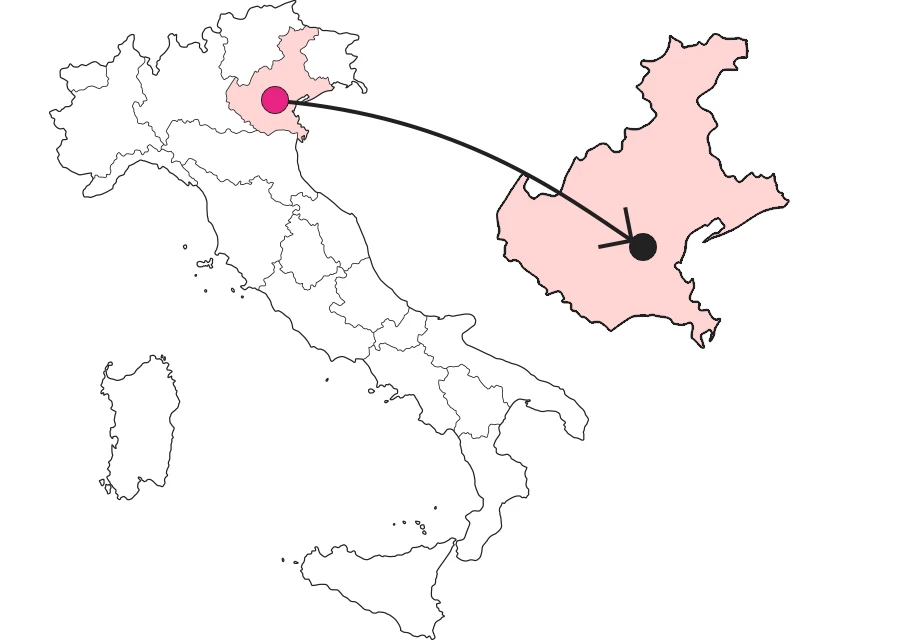












The working-class village of Paolo Camerini
Piazzola sul Brenta, forge of progress



Where

Piazzola sul Brenta, beyond the villa
The City of Piazzola sul Brenta is often identified with Villa Contarini - G. E. Ghirardi Foundation, which faces south on the majestic Piazza named after Paolo Camerini. In reality, as one enters the urban center and walks its streets, in addition to the Villa and Piazzola's seventeenth-century splendor, a discerning eye can discern legibly the twentieth-century face of the city, outlined precisely by Paolo Camerini. Housing solutions from the beginning of the last century stand out, connected with some curious architectural similarities. In fact, a part of these houses, close to the town center, show similar features and original forms, distinguishable even after restoration. They are some among the vestiges of the "modern company town" commissioned by Paolo Camerini (1868-1937) in the early 1900s. Paolo, the son of Luigi and Fanny Fava, inherited at age 21 the title of count and the Camerini's vast fortune, some 100,000 hectares of land, movable and immovable property including the Villa of Piazzola sul Brenta. His urban design was the result of the agro-industrial evolution that transformed Piazzola into one of the most important industrialized centers of the early 1900s. Today, several visible traces and buildings hark back to that ideal city he created.
Who were the Camerini
Let's take a step back and talk about the Camerini family and Paolo, who was the architect of Piazzola's major transformation from an agricultural, industrial and urban planning point of view. The Camerini family has origins in Romagna. Silvestro Camerini (1777- 1866) bought in 1852 the Piazzola properties of the Correr-Giovanelli family (heirs of the Contarini family), a land patrimony of almost 5,000 hectares, but it was with his nephew Luigi (1819 - 1885), who had been orphaned and raised by his uncle, that the complex and costly restoration of the Villa was begun. In Luigi Camerini's time Piazzola had as its most important activity a spinning mill in which the laborers were mainly women, but it was necessary to wait for his son Paolo to see the economic and social takeoff of the village. Paolo found himself administering an estate spread between the provinces of Padua, Rovigo and Vicenza. Having graduated in 1891 with a degree in Political Economy from the University of Padua with a thesis highlighting the situation of agriculture at the time in relation to international trade, property structures and workers' conditions, he used this student investigation of his to create the system of small plots of land (5-6 fields, extended to 50-60 in the more peripheral areas) with housing and stables later given to the families of colonist-workers of Piazzola. These are precisely the dwellings we referred to at the beginning of our story.
 Via Garibaldi, historical photo
Via Garibaldi, historical photoFrom agriculture to industry
The soil in the Piazzola countryside is not very fertile, and so in 1891 the chemical fertilizer factory was born. Now that it is in full development, Piazzola has an increasing need for housing, industrial facilities and building materials that are produced on site, in a new furnace, But the most important factory of this, which we can call a real "industrial pole" wanted by Paolo Camerini, is the jutificio. The area of the jute processing plant, which in the 1920s reached a thousand employees, is and today has been redeveloped for residential and commercial use, and is the most recognizable symbol of the Piazzola of the 1900s.
A great urban and social project
Paolo Camerini's great urban project was the result of the agro-industrial evolution that transformed Piazzola into one of the most important industrialized centers of the time. Some social buildings that still exist can help us imagine the life of the inhabitants of the time. As in an ideal city, the citizen who worked for Camerini lacked nothing. Paolo Camerini's idea of a "social economy" was to contribute one's wealth to the development of the community, not neglecting improvements to living conditions both at work and in old age. The labor supply that was created with him caused the population of Piazzola to increase from 3,500 in 1890 to about 8,000 in less than fifteen years.
 The Greek in the attic, typical of the Camerini Houses.
The Greek in the attic, typical of the Camerini Houses.Between past and present through the streets of Piazzola
Traces of this past can still be seen today, for example in Via Nizza (formerly Via Nizza Marittima), where most of the still-preserved Camerini houses can be seen, some recognizable by the characteristic "greca" in the attic on the street side. At the time, these houses provided a sluice, a fence between the house and the vegetable garden that Paolo Camerini rented to the family in addition to directions on what to grow. So the same family could provide both factory work and land cultivation. The harvest served Camerini's canned food industry, another novelty for that era. But it was not only the houses that remained; Camerini was inspired by the U.S. Company Towns that were born to reconcile home and work in a single town. Unlike other experiences of that type Camerini also had social buildings built for the most part still visible in Via dei Contarini, Via Rolando, Via Nizza and Via XX Settembre: among the social buildings we find the girls' elementary school, the public baths and showers with the music room, the stabling building with the performance hall, the recreation center with the canteen and dormitory, the gymnasium that in 1907 will become a cinema, the washhouse, the kindergarten, which with the war will become Casa del Fascio, the Camerini houses and the caravans , four multi-family blocks capable of housing a population of 40 families.
It is the details that make a great project
The industrial hub of this Camerini working-class village also had its own railroad. Opened in 1911, this private railway connected Padua to Piazzola and was extended in 1923 to Carmignano di Brenta. Camerini had it built to be able to transport raw materials to Piazzola quickly and less expensively and finished products out of town.
Enter the Map of Italy's Undiscovered Wonders and find treasures where you least expect it... Inspire, Recommend, Share...
Collections
The Map thanks:
In the Community
Enter the Map of Italy's Undiscovered Wonders and find treasures where you least expect it... Inspire, Recommend, Share...
Where

Collections

